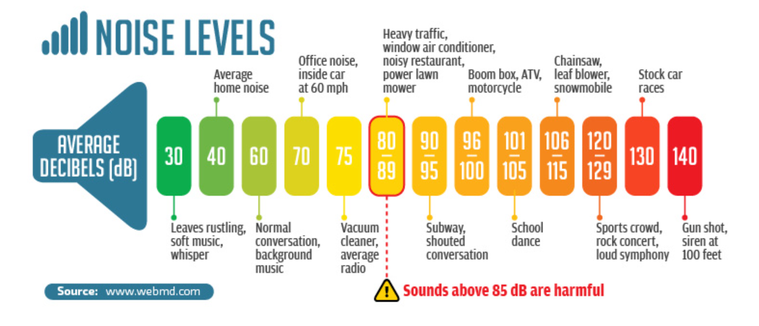

Serious damage possible in 8 hr exposure.īoeing 737 or DC-9 aircraft at one nautical mile (6080 ft) before landing (97 dB) power mower (96 dB) motorcycle at 25 ft (90 dB). Boeing 707 or DC-8 aircraft at one nautical mile (6080 ft) before landing (106 dB) jet flyover at 1000 feet (103 dB) Bell J-2A helicopter at 100 ft (100 dB).Ĩ times as loud as 70 dB. Jet take-off (at 305 meters), use of outboard motor, power lawn mower, motorcycle, farm tractor, jackhammer, garbage truck. Riveting machine (110 dB) live rock music (108 - 114 dB).Īverage human pain threshold. Turbo-fan aircraft at takeoff power at 200 ft (118 dB). Military jet aircraft take-off from aircraft carrier with afterburner at 50 ft (130 dB). Required as a result of a natural disaster.Recommended product: Outdoor Noise Barriers.R equired as a result of an airline model defect.Signed off by the Civil Aviation Authority or Minister of Transport.Undertaken on aircraft associated with Antarctic Operations.

Įxemptions to the above restrictions only apply to tests that are : The airport is only allowed to undertake five ‘U nplanned ’ or exempt tests per quarter or 12 per year.There will be no high power jet engine tests carried out between 10pm and 7am unless the test is 'Unplanned' or exempt.

All high power turbo-prop engine tests that are five minutes or longer between 10pm and 7am must be carried out on the threshold of Runway 11 unless otherwise in use.
 The noise emitted from engine tests shall not exceed a 75 dB L Amax between 10pm and 7am only as calculated at the edge of the residential zone. Aircraft engine testing noise shall not exceed 55 dB L dn at the 55 dB L dn engine testing noise contour, calculated as a 7 day rolling average. Aircraft engine testing noise shall not exceed 65 dB L dn at the 65 dB L dn engine testing noise contour, calculated as a 7 day rolling average. The Christchurch District Plan has a number of restrictions regarding engine testing noise. Instead, this kind of noise is called aircraft operational noise and has to comply with a different set of noise restrictions explained further down the page. It’s important to note aircraft engine testing does not include noise from aircraft taxiing, take-off and landing. Because the test ing happens in a closed environment, the potential for noise impact s are limited for these types of test s. In contrast, o ff-aircraft engine testing occurs when aircraft engines are removed for more rigorous repairs and testing occurs in an enclosed test cell. The noise emitted from these tests can be disruptive for nearby residents or sensitive activities. These engine tests are undertaken outside at various locations, depending on factors like wind direction, runway use and aircraft type. On-wing aircraft engine testing is any engine test performed while the engine is attached to the aircraft. Following overnight maintenance, the engines must be tested before aircraft go back into operation early the following morning. Regular maintenance is essential to a safe commercial aviation industry in New Zealand. Engine testing occurs during the night as plane maintenance can't occur during the day when aircraft are flying.
The noise emitted from engine tests shall not exceed a 75 dB L Amax between 10pm and 7am only as calculated at the edge of the residential zone. Aircraft engine testing noise shall not exceed 55 dB L dn at the 55 dB L dn engine testing noise contour, calculated as a 7 day rolling average. Aircraft engine testing noise shall not exceed 65 dB L dn at the 65 dB L dn engine testing noise contour, calculated as a 7 day rolling average. The Christchurch District Plan has a number of restrictions regarding engine testing noise. Instead, this kind of noise is called aircraft operational noise and has to comply with a different set of noise restrictions explained further down the page. It’s important to note aircraft engine testing does not include noise from aircraft taxiing, take-off and landing. Because the test ing happens in a closed environment, the potential for noise impact s are limited for these types of test s. In contrast, o ff-aircraft engine testing occurs when aircraft engines are removed for more rigorous repairs and testing occurs in an enclosed test cell. The noise emitted from these tests can be disruptive for nearby residents or sensitive activities. These engine tests are undertaken outside at various locations, depending on factors like wind direction, runway use and aircraft type. On-wing aircraft engine testing is any engine test performed while the engine is attached to the aircraft. Following overnight maintenance, the engines must be tested before aircraft go back into operation early the following morning. Regular maintenance is essential to a safe commercial aviation industry in New Zealand. Engine testing occurs during the night as plane maintenance can't occur during the day when aircraft are flying.








 0 kommentar(er)
0 kommentar(er)
